tabernacle lane
tabernacle lane
formerly Eagle Alley, Narrow Lane, Little Lane and Hannam's Lane
Tabernacle Lane, earlier called Little Lane, is a narrow alley running from the Borough to South Street. The earliest mention of what is now called Tabernacle Lane was in a document dated 1386 in the Woborn Almshouse archives, and another dated 1400, also mentions properties in the lane. In a Woborn Almshouse lease dated 1464 it is referred to as Narwelane (Narrow Lane). "Henry Sentclere of Wells and Johanna his wife to John Fyvyan and Johanna his wife, for 21 years, a messuage in the free borough of Yevele in the High Street between the lane called Narwelane on the east and the messuage lately belonging to John Barbor on the west together with a stable and cottage adjoining at an annual rent of 31s."
Until around 1790 there was an inn on the northeast corner of today's Tabernacle Lane called the Eagle Inn and the narrow lane was, for generations, known as Eagle Alley.
A serious fire occurred in 1802 in which many houses were destroyed. The following is an extract of a letter from Henry Penny to Mr R Donn of Exeter dated 1 October 1802 ".... it brake out last Thursday morning about 5 o'clock in a narrow lane called Little Lane just behind Mr Edwards' house - it has destroyed 13 dwellings besides outhouses. Our family and Mrs Donn were greatly frightened, as might be expected, but however I have the happiness to acquaint you that they are all as well as can be expected and that the damage sustained by me is very little. I had no other prospect when I first discovered it but having my house burnt down about my ears and nothing but the very greatest exertions of those employed saved me. Mrs Donn has lost 4 tenements in Back Street (today's South Street) amongst which is Jno Hodges' - her own house is not the least damaged...."
In the
mid-nineteenth
century it was
also called
Hannam’s Lane
because
Josiah
Hannam, a
senior member of
the Society of
Friends, had an
ironmongery
warehouse and a
yard there.
Hannam also
owned a hardware
shop on the
corner of
Tabernacle Lane
and the
Borough in
premises which
had formerly
been an inn
which at first
had been called
the
Lyon Inn
then the Eagle
Tavern and
finally the
Falcon Inn.
However
Tabernacle Lane
has been most
often used since
the founding of
the Tabernacle
Meeting House in
1804.
In the 1841 census three
families were
listed as living
in Tabernacle
Lane; blacksmith
Henry Bragg, his
wife Susan and
their nine
children,
25-year old
dressmaker
Charlotte Pitman
and her
four-year old
daughter Mary,
and finally
glover William
Leach, his wife
Harriett and a
13-year old lad
called John
Fooks. Henry
Bragg's house
and
smithy are
shown on the
second of the
maps below. He
lived and worked
here for some
twenty years and
his widow,
Susan, lived on
here until the
1870's.
In the 1851 census it was
called Hannam’s
Lane and by this
time
John Perry
had taken over
the blacksmith’s
shop. He was
living there
with his wife
Jemima and their
five children,
including son
Philip who, at
the age of 14
was listed as a
blacksmith
journeyman –
inferring he had
served a seven
year
apprenticeship!
Also living in
Hannam’s Lane
were van driver
John Winsley and
his family,
umbrella maker
Silas Hebditch
and his family
and whitesmith
Henry Bragg and
his family – a
total of 27
people.
The 1861 census called the lane 'Little Lane' and listed eight families in residence there - those of hat maker Thomas Lawrence, carpenter Thomas Hodges, blacksmith George Hull, widowed leather glove maker Susannah Bragg, tailor George Margetts, carpenter Herbert Hodges, boot & shoe maker John Griffin and servant at the gas works Arthilus Collier - a total of 32 people.
By the 1871 census the name had reverted to Tabernacle Lane and included the four families of annuitant Susan Bragg, blacksmith John Higdon, wheelwright Herbert Hodges and farm bailiff's wife Mary Dawe totaling seventeen people.
The number of families had reduced to two by the 1881 census and Susan Bragg who had lived in the lane since at least 1841 had died. Herbert Hodges was still making wheels and James Brown had taken over the blacksmith's forge. A total of eleven people lived in the lane at this time.
The 1891 census
shows that the
number of
families living
in Tabernacle
Lane had
increased and
included colt
breaker and
groom William
Green and his
family living in
Henry Bragg's
old house,
agricultural
labourer John
Priddle and his
family were
living next door
at No 2. In No 3
was sausage
maker John
Hodges and his
family and then
came blacksmith
George Brown,
brother of
James, and his
family living at
No 4. (James
Brown had gone
into business
with Albert
Winsor, father
of
Percy Winsor,
based at 62 & 63
South Street). Finally,
in No 5 was
Sergeant
Instructor of
volunteers
William Campbell
from Ireland and
his Welsh wife
Ellen.
In the 1901 census there
were still two
families living
in Tabernacle
Lane, a total of
sixteen people;
factory hand
George Courtney,
his wife and six
daughters and
general labourer
George Rendell,
his wife and six
children.
MAPs
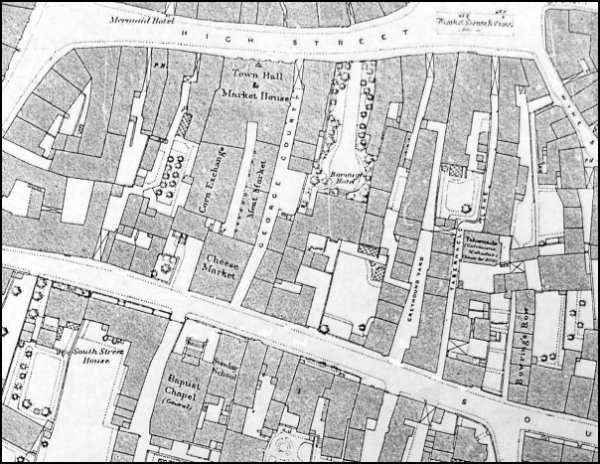
The 1886 Ordnance Survey showing High Street running across the top of the map and South Street at the bottom. Tabernacle Lane is at centre right running between the two.
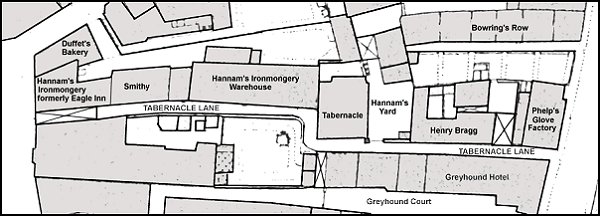
This map is based on the 1886 Ordnance Survey above, but rotated 90° with the Borough at extreme left and South Street at extreme right. The dwellings in Tabernacle Lane included those behind the Greyhound Hotel since the dwellings in Greyhound Court were just off the bottom of the map.
gallery
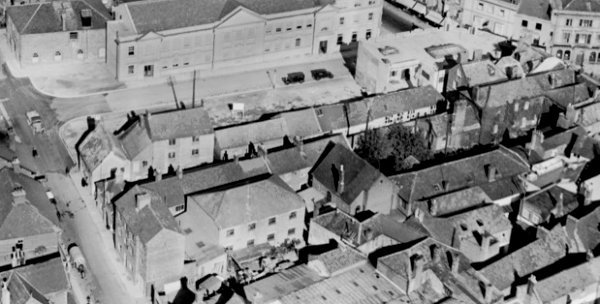
This aerial photograph dates to 1928 and shows South Street at left, High Street at top right and the newly-built King George Street running between the two at the top of the photo. Note that at this time the post office building along the eastern side of King George Street was yet to be built. At centre left, more or less on the corner of King George Street and South Street, is the thatched Cow Inn and behind it, and running parallel to King George Street are the dwellings in Greyhound Yard. The three-storey building next to the Greyhound Hotel was Henry Phelps' glove factory and to the right of it in the photo are visible the rooftops of the dwellings in Tabernacle Lane. At centre is seen the dark pitched roof of the Tabernacle itself.

Tabernacle Lane photographed from the Borough in the 1960s. Note that the arches to both the lane and the windows of Hill & Sawtell's shop at the right were still rounded at the top.
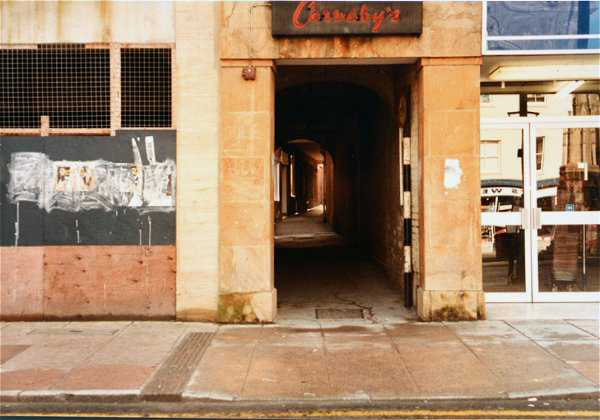
Courtesy of
Chris Rendell
The entrance to Tabernacle Lane seen from the Borough. Photographed in 1985.
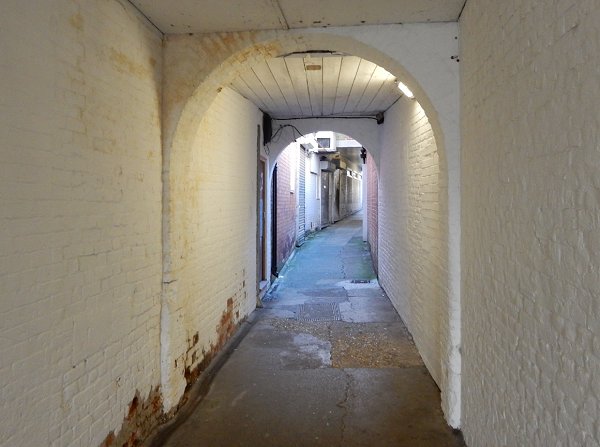
This photograph
features in my
book "A-Z
of Yeovil"
Venturing just a few steps inside from the Borough - the brick arches are original. Photographed in 2016.
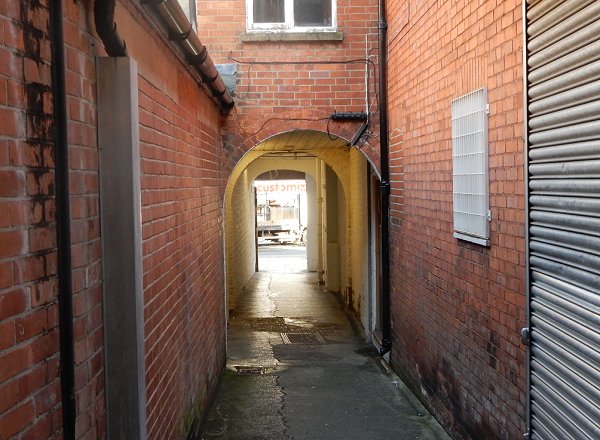
.... and looking back towards the Borough. How many of us queued here to get into the various nightclubs, such as Carnaby's that opened upstairs here in October 1971. Photographed in 2016.

An advertisement in the 5 October 1973 edition of the Western Gazette celebrating the second birthday of Carnaby's nightclub.

This
colourised photograph
features in my
book "Lost Yeovil"
This photograph was taken around 1960, before the demolition of the buildings on the right. The gabled building at the end on the right by the two people is the tabernacle that gave this alley its name.
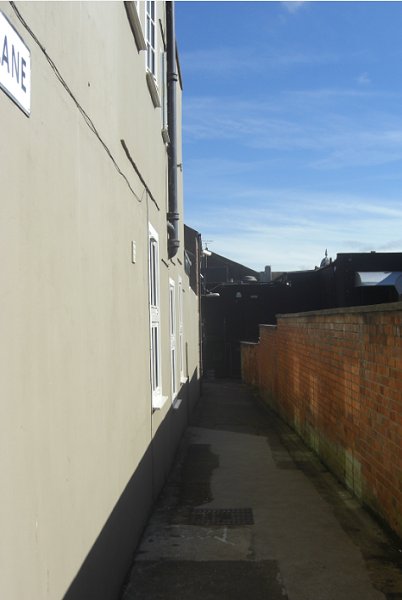
Almost the same view in 2013.

Approaching the dog-leg from High Street, this corner is about all that remains of the tabernacle. Photographed in 2013.
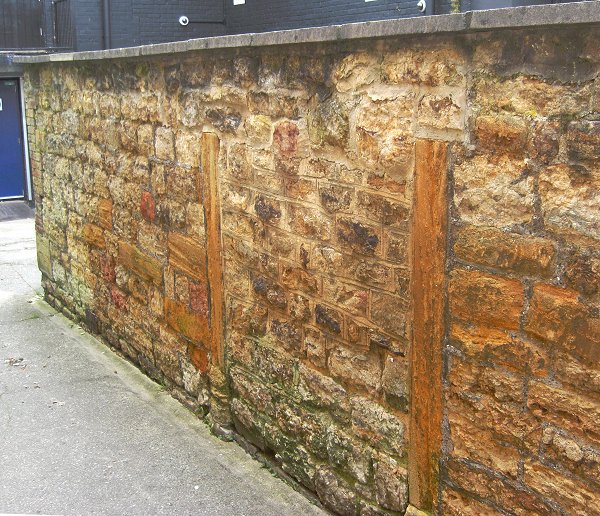
The wall by the dog-leg, these are the Ham stone door jambs of the original tabernacle. Photographed in 2013.
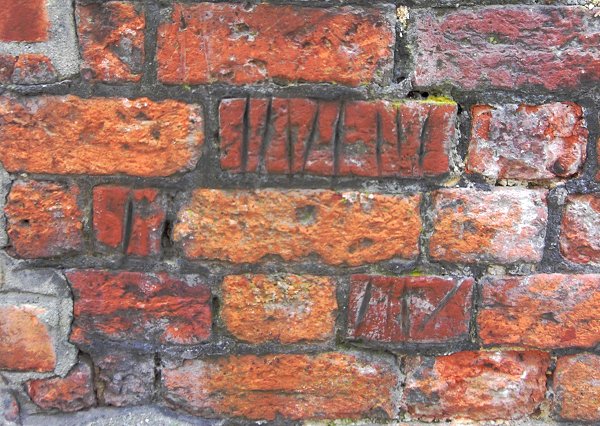
One of those little items that makes Yeovil so special - these scratches in the soft red Yeovil bricks are at the end of Tabernacle Lane near South Street. They were made by Victorian children sharpening their slate pencils on their way to school in South Street. Photographed in 2013.